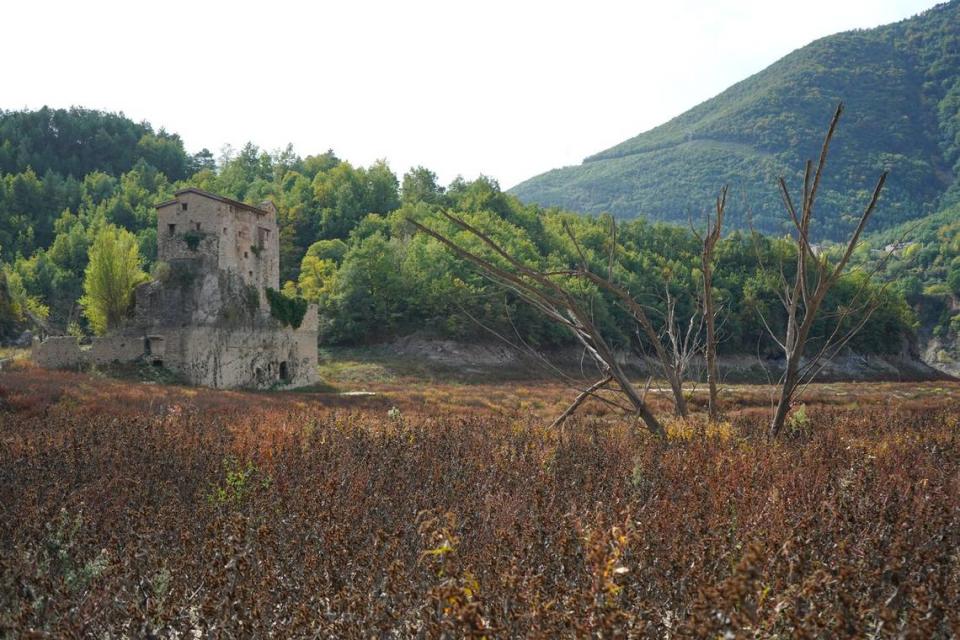Millennium-old monastery emerges from lake in drought-stricken Spain, photos show
At once imposing and captivating, a ninth century monastery stands out against its surroundings. The isolated structure is usually its own island, enclosed by the calm waters of a reservoir in eastern Spain.
But not now.
Now, the structure stands lonely and barren without a drop of water in sight.
The Monastery of Sant Salvador de la Vedella was built in 830 A.D. atop a cliff, according to the Municipal Council of Cercs. The complex consisted of several buildings and overlooked the nearby village.
All of that changed in 1976 when several villages were evacuated for the creation of the Baells reservoir. The villages were consolidated, and the town of Sant Jordi de Cercas was created, council officials said.
The monastery — jutting out above the reservoir waters — became the only building left standing from the ancient village. Photos shared by the Catalan Water Agency in 2017 show the resolute stone building.
Now, the Baells reservoir looks drastically different, impacted by Spain’s ongoing drought, the Catalan Water Agency said in a Facebook post. The water authority shared photos and video of the shocking scene.
From the dry ground of the reservoir, the tall monastery disrupts the otherwise natural-looking landscape.

Up close, a worn path surrounds the monastery’s cliff. The ruins of several long-gone buildings sit off to the side, video shows. Seen from above, it’s almost hard to envision that this 1,100-year-old monastery is usually in a lake.
The monastery of Sant Salvador de la Vedella is about 75 miles northwest of Barcelona.
Water levels in the Baells reservoir dropped to only 25% capacity on April 24, according to data from the Catalan Water Agency. One year ago, the reservoir was filled to 55% capacity.
Regionally, the situation is equally difficult with Catalonia’s reservoirs at only 26% capacity, water officials said. Another drought warning sign — a crumbling 11th century church — resurfaced recently from the Sau reservoir.
“This is a very critical situation,” Samuel Reyes, director of the Catalan Water Agency, told BBC. “This drought in Catalonia is a marathon. The worry is that we are on alert not just for two years or so, but for three or four years.”
Several compounding factors have contributed to the shrinking reservoirs including high temperatures, persistent lack of rainfall and a long-term drought exacerbated by climate change.
Spain entered a long-term drought at the end of 2022 after months of below-average rainfall and a warmer-than-usual winter, according to a March news release from the State Meteorological Agency, AEMET, and Ministry for the Ecological Transition and the Demographic Challenge.
In the first half of April, over half of Spain has not seen a single drop of rain, AEMET said in an April 19 post on Twitter. Officials expect this April will be one of the driest ever recorded.
But Spain is not the only European country facing drought conditions.
“Impacts of the emerging drought are already visible in France, Spain, and northern Italy,” the European Drought Observatory said in a March report, echoing warnings.
“The persistent lack of precipitation and a weeks-long sequence of warmer-than-average temperatures” contributed to the risk of an impending drought, officials said. If conditions persist, “the current situation may become critical in the coming months.”
Google Translate was used to translate news releases, Facebook posts and Instagram posts from the Catalan Water Agency; news releases from the Ministry for the Ecological Transition and the Demographic Challenge; the website of the Municipal Council of Cercs; and Twitter posts from the State Meteorological Agency, AEMET.
Crumbling 11th century church resurfaces — a warning sign for drought-stricken Spain
Millions of dead fish fill a river in Australia, videos show. What caused the die-off?

